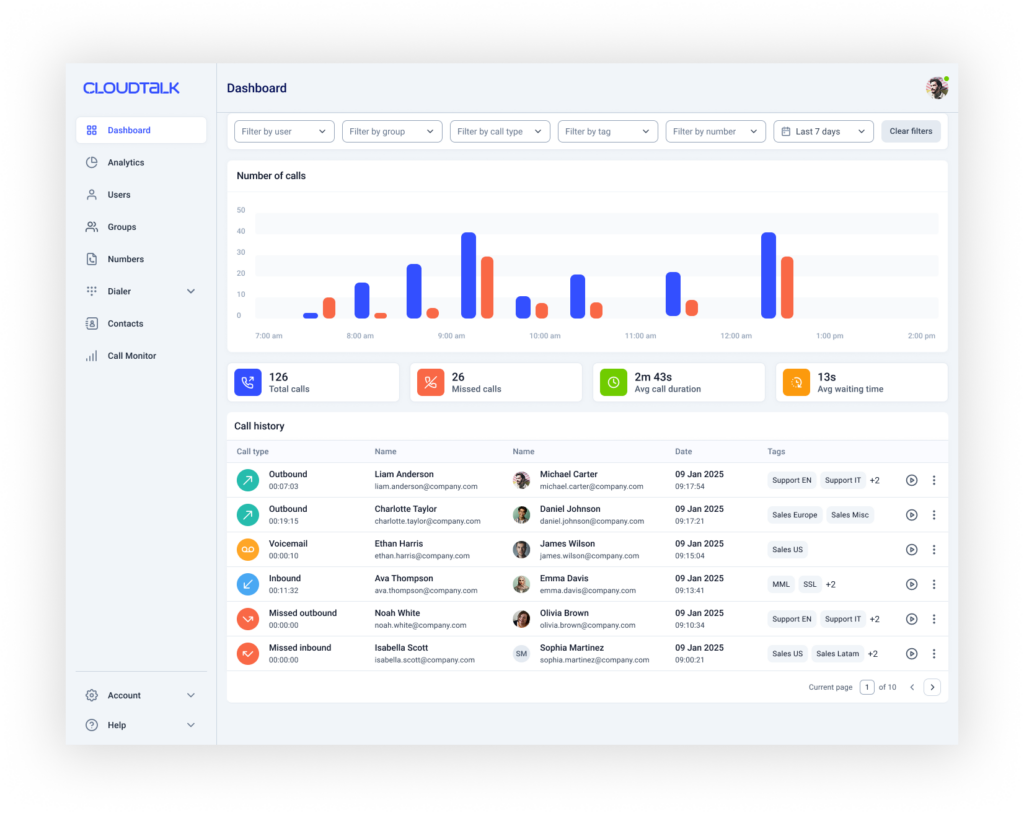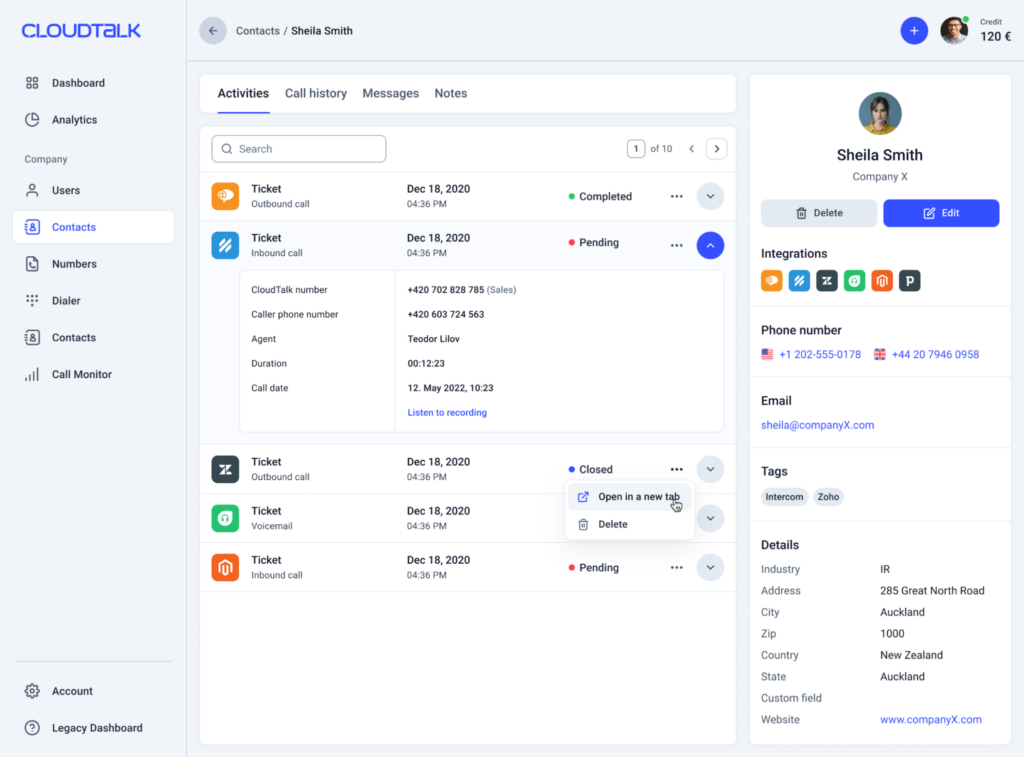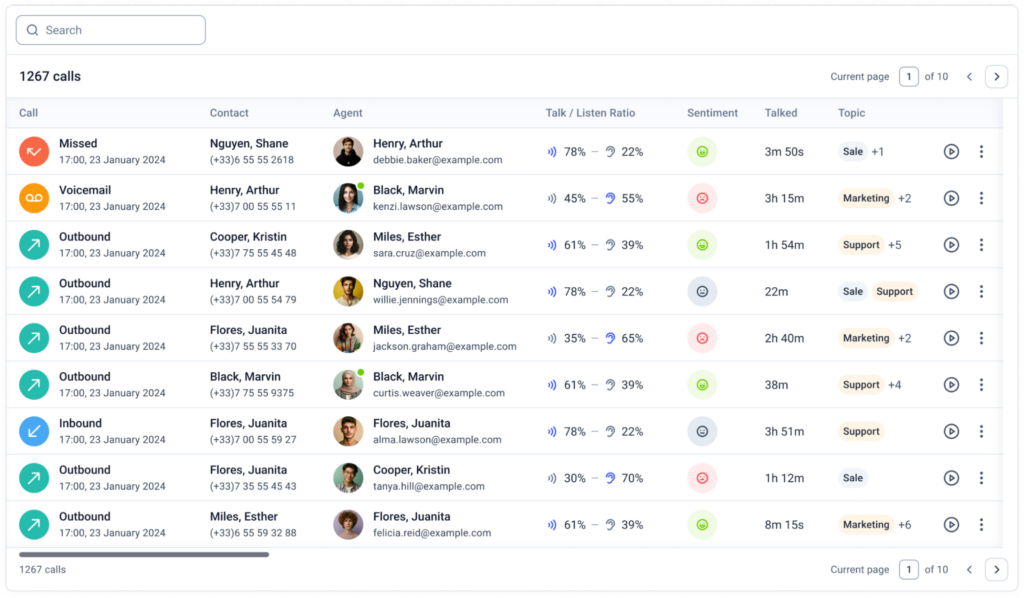Contact Center Vs. Call Center: What Is the Difference?

“Call center or contact center?” It might seem like a minor distinction, but the stakes are high—79%1 of customers won’t hesitate to switch to a competitor for a better experience. Behind these similar-sounding terms lie fundamentally different approaches to customer communication.
The choice between contact center vs. call center shapes everything from your team structure and technology requirements to customers’ perception of your brand.
As expectations continue to evolve, it becomes essential to build a service infrastructure that balances operational efficiency with exceptional customer experiences, ultimately influencing your ability to retain customers and grow your business.
Key Takeaways:
- Match your model to customer behavior – Let actual customer preferences guide your decision. If your audience predominantly reaches out by phone, a call center may be most effective.
- Consider your operational readiness – Contact centers require more complex technology integration and cross-channel agent training. Ensure you can deliver consistent quality across all channels before expanding beyond voice.
- Plan for evolution – Design your initial customer service infrastructure with future growth in mind. Choose solutions that can scale with your business, allowing seamless transition from call center to contact center when the time is right.
Boost customer engagement with the right communication solution.
What is the Difference Between a Contact Center Vs. Call Center?
Despite often being used interchangeably, call centers and contact centers represent distinct customer service models. Understanding their differences is crucial for businesses looking to implement the right customer communication strategy.
The primary distinction lies in the channels they support: call centers focus exclusively on voice communications, while contact centers embrace an omnichannel/multichannel approach spanning voice, email, chat, social media, and more. This core difference cascades into variations in technology requirements, agent skills, customer experience, and overall business impact.on – see what CloudTalk has to offer.
Feature
Contact Center
Call Center
Communication channels
Phone, email, live chat, social media, and more
Phone
Support type
Proactive & Reactive
Reactive
Automatic distribution
All tickets across the channels
Calls
Software
All-in-one omnichannel solution or a combination of integrated tools
A single, dedicated call center tool
Virtual vs on-premise
Virtual
Virtual or on-premise
Self-service management
Self-service portal, chatbots, community forums
IVR
Use cases
Omnichannel/multichannel customer service, virtual contact center, personalized self-service
Phone-based customer service, cold calling & outbound sales, lead qualification & nurturing, market research, information gathering, fraud prevention, debt collection
Benefits
Advanced ticket routing, task automation across the channels, unified customer data & consistent experience, shorter wait times and more flexibility for customers, more proactive support
Advanced call distribution, handling a high volume of calls, more in-depth call analytics, cheaper to maintain and easier to manage, less risk
Communication Channels: Single vs. Multi-channel
Call centers focus exclusively on voice communication. Agents specialize in handling phone calls, mastering the nuances of tone, pacing, and verbal problem-solving.
This voice-centric approach creates a direct line between customers and support teams. For industries where complex explanations or sensitive discussions are common, this dedicated phone channel remains invaluable.
Contact centers incorporate multiple communication channels beyond voice—email, chat, SMS, and social media. This multi-channel structure allows businesses to meet customers where they are, whether they prefer immediate voice conversations or text-based communication that fits into their schedule.
Support Structure: Focused vs. Diversified Systems
Call centers utilize specialized phone systems optimized for call routing, queuing, and distribution. These systems excel at managing high call volumes efficiently across agent teams.
The streamlined infrastructure concentrates on doing one thing exceptionally well—connecting customers to the right agent quickly when they call for assistance.
Contact centers employ more complex platforms that handle various communication types simultaneously. These systems must coordinate tickets and customer data across multiple channels.
This requires more sophisticated routing rules and integrations to ensure consistent service regardless of which channel a customer chooses to use.
Agent Specialization: Voice Experts vs. Channel Adapters
Call center agents develop deep expertise in voice communication skills. They excel at active listening, verbal problem-solving, and managing conversations efficiently without visual cues.
This specialization allows agents to handle complex issues through carefully structured phone conversations, creating clarity where written communication might introduce ambiguity.
Contact center agents must adapt to different communication styles across channels. They switch between the immediacy of voice calls and the more measured pace of email or chat interactions. This versatility requires agents to have specialized training to acquire a more diverse skillset.
Technology Requirements: Streamlined vs. Integrated
Call centers need robust telephony infrastructure but typically require less complex technology stacks than full multi-channel operations.
The focused technology requirements often translate to lower implementation costs and more straightforward system maintenance, making sophisticated call management accessible to more businesses.
Contact centers depend on integrated platforms that connect diverse communication channels with unified customer data. This requires more complex implementation and ongoing administration.
The technology must maintain a single customer view across all touchpoints while providing agents with relevant context regardless of which channel is being used.
Operational Approach: Deep vs. Broad Coverage
Call centers optimize for voice traffic patterns, staffing around peak call times and measuring metrics specific to phone interactions like average handle time and first-call resolution.
This focused operational model creates efficiency through specialization, allowing businesses to perfect their voice support processes.
Contact centers balance resources across multiple channels, managing varied response time expectations—from immediate phone support to somewhat delayed email responses.This requires more complex workforce management to ensure appropriate coverage across all channels while maintaining consistent service standards regardless of how customers choose to connect.
Transform your phone support into a world-class experience. Start your CloudTalk trial!
What Is a Contact Center?
We already gave away the definition in the previous section, so here’s what a contact center actually looks like in action:
A retail company might use a contact center to allow customers to start a product return process through chat, receive confirmation via email, and follow up with questions by phone—all while agents maintain complete visibility of the entire interaction history.
No “please explain your issue again” moments. No details lost between channels.
That’s the magic of a contact center.
Cloud-based solutions have made this technology accessible for businesses of all sizes who need to manage conversations across multiple channels while maintaining that golden thread of context customers expect.
The core components include:
- Unified Communication Platform: Consolidates all customer interactions in one system, regardless of channel
- Intelligent Routing Technology: Directs inquiries to the appropriate agent based on skills, availability, and customer needs
- Integrated CRM Tools: Provides agents with complete customer history and context for personalized service
- Analytics and Reporting: Offers insights into performance metrics, customer sentiment, and operational efficiency
- Self-Service Options: Includes knowledge bases, chatbots, and automated systems for handling routine inquiries
- Workforce Management: Optimizes agent scheduling and resource allocation across channels
What is a Call Center?
Voice communication remains unmatched for complex problem-solving. There’s something powerful about hearing a confident human voice say, “I understand your situation, and here’s how we’ll fix it.”
That’s why even digitally-advanced companies maintain dedicated call centers—specialized operations where agents focus exclusively on mastering voice communication.
Modern call centers have evolved far beyond fluorescent-lit rooms filled with cubicles. Today’s call center might be a distributed team using sophisticated cloud-based phone systems that integrate seamlessly with your business tools.
Modern call center infrastructure includes several essential components:
- Voice-Over-IP (VoIP) Technology: Forms the foundation for handling high call volumes efficiently
- Interactive Voice Response (IVR): Guides callers through menu options to reach the right department
- Automatic Call Distribution (ACD): Routes incoming calls to appropriate agents based on predefined rules
- Call Recording and Monitoring: Enables quality assurance and training through call analysis
- Performance Analytics: Tracks key metrics like average handle time, first-call resolution, and wait times
- CRM Integration: Connects caller information with customer history for personalized service
- Call Queuing Systems: Manages caller wait times and provides estimated wait information
- Real-Time Dashboards: Offers real-time visibility into team performance and call volume

Financial institutions rely on dedicated call centers to handle sensitive transactions and account inquiries. A regional bank, for example, might use CloudTalk’s software for:
- Efficient call management: Advanced call routing directs customers to the right specialists.
- Regulatory compliance: Call recording ensures adherence to industry standards.
- Optimized staffing: Analytics help manage peak call volumes effectively.
While call centers focus on voice interactions, modern solutions like CloudTalk enhance efficiency through automation and integrations.
This enables businesses to maintain detailed customer records, streamline processes, and deliver personalized support without adding complexity.For industries where verbal communication is critical—like healthcare, finance, or tech support—a well-structured call center balances specialization with efficiency, creating seamless customer experiences.
Explore the latest innovations in call center software.
Key Similarities Between Call and Contact Centers
Despite their differences, call centers and contact centers share important foundational elements. Understanding these similarities helps clarify when either solution might be appropriate for your business needs.
Both Focus on Customer Experience Optimization
Regardless of channel strategy, both models ultimately share the same goal: delivering exceptional customer experiences that build loyalty and drive business growth.
Call centers and contact centers both implement quality assurance programs, customer satisfaction measurement, and voice-of-customer feedback loops to continuously refine their service delivery.
The metrics may vary slightly, but the commitment to customer-centricity remains constant.
Modern call center solutions and contact center platforms alike incorporate features designed to enhance customer experience—from personalized greetings based on caller identification to seamless knowledge base integration for faster issue resolution.
This shared focus on customer experience represents perhaps the most important similarity between these models, reminding us that while technology and channels may evolve, the fundamental purpose of customer service remains unchanged.

Both Prioritize Voice Communication
While contact centers embrace multiple channels, voice remains the backbone of customer communication in both models. Phone conversations continue to be the preferred medium for complex issue resolution.
In fact, customers typically escalate to voice calls when facing complicated problems or when emotional reassurance is needed. Both call centers and contact centers must excel at voice interactions to deliver effective customer service.
The underlying call routing technology, agent voice training, and call quality standards remain essential whether you’re operating a dedicated call center or a multi-channel contact center. Voice excellence forms the foundation upon which all other communication channels build.
Both Require Sophisticated Workforce Management
Whether managing voice-only agents or multi-channel teams, both environments demand strategic workforce planning and scheduling. Peak volume periods must be adequately staffed while avoiding costly overstaffing during slower periods.
Advanced call center technologies now offer AI-powered forecasting tools that analyze historical patterns to predict staffing needs with remarkable accuracy. These workforce management capabilities have become essential in both call centers and contact centers to maintain service quality while controlling operational costs.
The principles of effective agent coaching, quality monitoring, and performance management also remain consistent across both models, with supervisors playing crucial roles in developing high-performing teams.

Both Leverage Advanced Analytics and Reporting
Data-driven decision making defines modern customer service operations regardless of channel strategy. Both call centers and contact centers deliver powerful analytics capabilities.
Call centers typically provide detailed metrics on call volumes, handle times, resolution rates, and agent performance. Contact centers extend these insights across additional channels while maintaining comparable depth of voice analytics.
This robust reporting empowers managers to optimize operations, identify training opportunities, and track customer satisfaction across service touchpoints—creating a culture of continuous improvement in both environments.

Contact Center vs. Call Center: Which One Should You Choose?
Selecting between a call center and a contact center isn’t just about following trends—it’s about aligning with your business needs, customer expectations, and growth trajectory. Let’s break down when each option makes the most strategic sense.
Choose a call center when:
Your customers prefer voice communication
Phone calls remain the preferred channel for many customer segments, particularly for complex problem-solving or sensitive discussions. If your analytics show that most customers reach out by phone regardless of alternative options, a specialized call center may be your best investment.
You’re operating in a voice-centric industry
Some sectors naturally demand voice communication—healthcare, financial services, crisis management, and technical support often require real-time, nuanced conversation that only voice can deliver effectively.
You have budget constraints
Starting with a focused call center solution allows you to invest in excellence within one channel rather than stretching resources thin across multiple channels. This targeted approach often delivers better ROI for growing businesses.
You need specialized compliance features
Regulated industries often have specific requirements for call recording, verification, and documentation. Dedicated call centers typically offer more robust voice-specific compliance features than broader contact centers.
Your team size is limited
With smaller teams, asking agents to master multiple communication channels can reduce overall service quality. A call center allows your team to perfect one critical skill set before potentially expanding to other channels.
Learn why modern businesses are adopting contact centers.
Choose a contact center when:
Your customers are channel-switching
If your data shows customers starting conversations on chat, then emailing, then calling—all about the same issue—you’re seeing the classic sign that a contact center is needed. When customers are forced to repeat themselves across channels, satisfaction plummets.
You need to balance traffic and wait times
Contact centers allow customers to choose less congested channels during peak times, reducing frustration and balancing your team’s workload. This flexibility helps maintain service levels even during unexpected volume spikes.
You’re targeting diverse demographics
Different age groups and market segments often have distinct channel preferences. Younger customers might prefer chat or social media, while older demographics might favor phone calls. A contact center lets you meet each group where they’re most comfortable.
You’re scaling rapidly
As businesses grow, customer communication needs become more complex. A contact center provides the infrastructure to scale across channels without major system overhauls, making it a forward-looking choice for businesses on growth trajectories.
You value comprehensive customer journey data
Contact centers create unified customer profiles across all channels, generating richer insights that drive more informed business decisions about product development, marketing strategy, and service improvements.
Insight
Many businesses find success starting with a focused call center, then evolving to a contact center as they scale.
Making the Right Choice for Your Customer Service Strategy
At the end of the day, all that matters is choosing what fits your customers best. Some businesses thrive with the simplicity and focus of call centers, while others need the flexibility of a multi-channel approach. The real key?
Making sure your service feels effortless for the people who rely on it.
Think of it this way: a call center is like a well-oiled machine, keeping conversations direct and efficient. A contact center, on the other hand, is more like a Swiss Army knife—equipped for different situations, ready to meet customers wherever they are.
Both can be powerful when used the right way.
For SMBs and growing businesses, starting with a call center often makes the most sense. It’s cost-effective, easier to manage, and lets you master one channel before expanding. Once your customer base and team grow, transitioning to a contact center can be a natural next step.
Build strong foundations first—then scale when the time is right.
Try 14 days for free and then enjoy 50% off your first month!
Sources:
FAQs
What Should I Consider When Choosing a Call or Contact Center?
Choose based on customer preferences, communication needs, and scalability. Call centers focus on voice; contact centers handle multiple channels efficiently.
How Is Training Different for Call and Contact Center Agents?
Call center agents specialize in verbal communication, while contact center agents train across channels like chat, email, and social media for flexibility.
Do Customers Prefer Call or Contact Centers?
Preferences vary; some prefer phone support for complex issues, while others value multichannel options like chat and email for convenience and speed.
How to Migrate from a Call Center to a Contact Center?
Gradually integrate new channels, train agents for multichannel support, and adopt an omnichannel platform to unify customer interactions seamlessly.
What Is the Difference Between Customer Service and a Contact Center?
Customer service is the overall support experience; a contact center is the platform used to deliver it through voice, chat, email, and other channels.
What Is the Difference Between a Service Center and a Call Center?
A service center handles various customer needs beyond calls, including in-person support, while a call center specializes in handling phone inquiries.
How Much Does a Contact Center Cost?
Costs depend on technology, staffing, and channels. Cloud-based solutions start at affordable rates, while enterprise platforms require higher investments.
How Much Does a Call Center Cost?
Call center costs vary based on software, staffing, and infrastructure. Cloud-based solutions offer budget-friendly options compared to traditional setups.
























